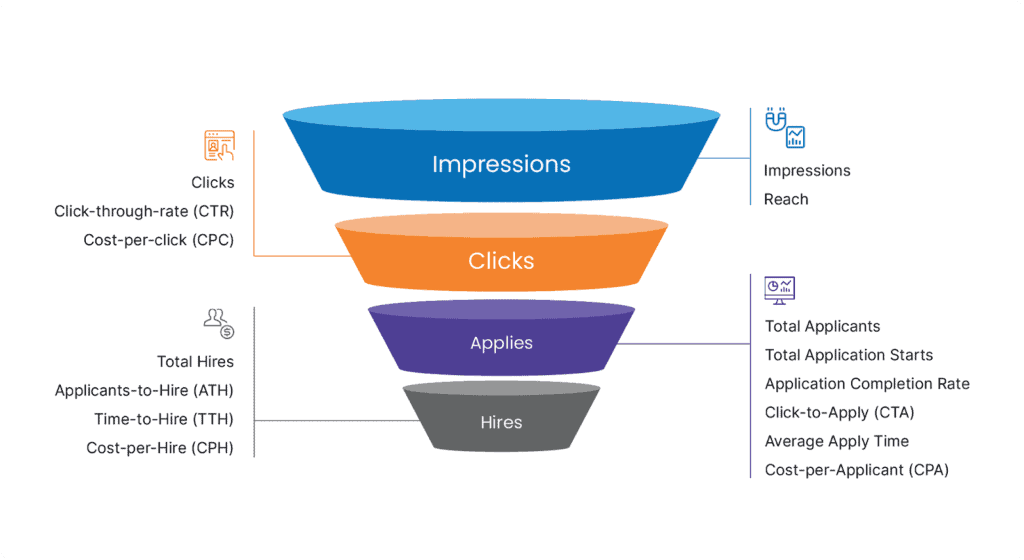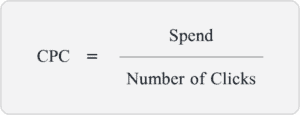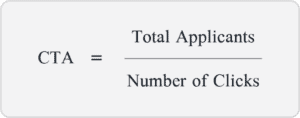“Work implies not only that somebody is supposed to do the job, but also accountability, a deadline and, finally, the measurement of results —that is, feedback from results on the work and on the planning process itself.”
– Peter Drucker, often considered the founder of modern management, wrote in Management: Tasks, Responsibilities, Practices.
In the world of recruitment advertising, measurement makes a world of difference.
Job advertising is all about getting in front of the right talent, through the right channels, at the right time… and at the right cost.
But whether you’re running your talent attraction campaigns on pay per click (PPC) job boards, duration / slot based job boards, Google AdWords, Facebook, or even organic channels, unless you track and analyze the right metrics, you most likely won’t make the right decisions
What are recruitment advertising metrics?
These are the attributes you ought to measure to track recruitment advertising success and optimize the overall hiring process for better applicant quality, reduced time to fill open positions, and greater ROI. The more granular you get, the more control you have on your hiring outcomes.
Why is tracking recruitment advertising metrics so important?
The world of job advertising can still be a bit chaotic. Recruiters are learning as they go, testing theories, relying on intuition to make decisions, and validating hunches. Sometimes, it’s hard to even know what questions to ask, let alone finding the right answers. Where are the connections? By pulling here, how does it affect things over there?
Introducing metrics makes this process much more scientific and data-driven, as opposed to so many of the “spray-and-pray” approaches that are followed till today – for instance, advertising on job boards or certain social media channels just based on their popularity and with little regard for the type of target audience or their preferred platforms.
Looking at the right job advertising metrics can help you figure out what’s working in your process and what isn’t, so you can make better (and more informed) decisions.
We’ve put together a list of the top recruitment advertising metrics every recruiting marketer or talent acquisition leader should be tracking.

What are you spending or planning to spend on your job ads?
1. Budget: The total amount of money allocated for your job advertising efforts.
The overall budget and its distribution, across jobs, job groups, campaigns, and sources (or job boards), is key to initiating your job advertising program. This metric will influence almost your entire job advertising strategy as well as results.
The recruitment advertising budget should ideally be estimated based on how much it costs you to make one hire for a particular job and the number of hires you need. However, this is not often in the recruitment marketer talent acquisition leader’s control – they need to work with what they’re given.

2. Spend: The total amount of money you spend on job advertising overall, or specifically, on a job, job group, campaign, or source.
This metric gives you some insight into which sources are delivering high-quality, cost-effective candidates.
In the programmatic job advertising world, your spend on certain hard-to-fill jobs can help you determine if adequate budget has been allocated (separately) for only those roles and if they will be receiving sufficient traffic to hit their goals.
Comparing this metric with your budget at any given point in time, will also help you understand if you are likely to overspend or underspend, allowing you to tweak your daily / weekly budgets accordingly. If your hiring goals are spread evenly across several weeks or months, the spend can be “paced” to control the rate of budget consumption over time.
We let you in on the best tools and platforms, top-notch metrics worth tracking, and industry best practices for optimal results.
Ready to Master the Art of Recruitment Advertising for Peak Performance?
Are enough high-quality candidates seeing your job ads?
3. Impressions: The number of job seekers that have been exposed to your job ads.
4. Reach: The number of potential candidates that will be exposed to your job ads through a particular job board or publisher.
These metrics track whether you’re casting your net wide enough and if you’ve chosen the right set of publishers – to get you an adequate number of views among your target audience of job seekers to meet your goals.
They might sound similar but are a bit different – if you run a job ad more than once, the same people may see the ads multiple times (more impressions), but you only want to count them once to calculate reach.
Are high-quality candidates interested in your jobs?
5. Clicks: All the clicks received on your job ads – segmented by jobs, job groups, campaigns, or sources.
The number of clicks reveals whether or not your job ad content is enticing enough for your target job seekers (to want to learn more). If you’re not getting sufficient clicks on your ads, you should consider trying different messages, placements, and sources.
While a lot of job advertising decisions are made based on this metric, it is worth noting that not all clicks are equal! The probability of a click ultimately converting to a hire depends on a number of factors, including where your job ads are published
- Bot clicks are clicks made by online bots. These come from machines, not humans, and therefore, will never convert to hires.
- Duplicate clicks are multiple clicks that originate from the same IP address or tracking URL within a defined period.
- Foreign clicks are clicks that come from a geographical location (city, state, or country) different from the ones targeted by your job ads.
Bot, duplicate, and foreign clicks must be removed from your calculation while evaluating your job ad performance as well as when you’re settling job board / advertising agency invoices.
- Latent clicks are clicks that occur after a campaign has been paused. The latency threshold determines the grace period during which these clicks would be considered valid or billable.
6. Click-through-rate (CTR): The rate at which job seekers engage with (click on) your ads on a job board, search engine results page, or social media.

This metric provides some insight into your job ad content effectiveness as well as the relevance and performance of the source (for a particular type of job).
Higher the CTR, the more engaging your job ads are and better the source. If your CTR is low, you might want to experiment with different messages, placements, and sources.
7. Cost-per-click (CPC): The amount you pay for every (candidate) click on your ad.

This is often considered one of the most critical job advertising metrics to track and optimize in job advertising, especially as a large number of job boards (as well as search engines and social channels) have performance-based pay-per-click (PPC) job ad placement models.
It indicates how competitive your job ads are and impacts the rate at which your budget is consumed. Your CPC bids also determine where and how often your job ads are shown to your target audience.
Is your job application process delivering a great candidate experience?
8. Total applicants / applications: All the job applicants / applications received in your ATS (applicant tracking system) – segmented by jobs, job groups, campaigns, or sources.
(The number of applications might be a bit higher than the number of applicants as the same applicant can apply to a job more than once.)
The total number of applicants received from a source highlights where your conversions (applicants) are truly coming from and if that source is contributing adequate volume (of high-quality candidates) to meet your hiring goals. This can also help you determine your most (and least) effective sources, so you can make necessary changes to your job advertising strategy.
This metric often has a very direct correlation with the number of hires, though it’s not always the case.
9. Total application starts: The number of times job seekers have started applying for your jobs – also segmented by jobs, job groups, campaigns, or sources.
If this metric is very low in comparison to the number of clicks, there might be an opportunity to update and improve your job descriptions to make them more appealing to candidates as well as inclusive (eliminating bias).
10. Application completion rate: The ratio of the number of candidates that complete an application and submit it for consideration, to the total number of candidates that start that application.
11. Click-to-apply (CTA) conversion rate: The ratio of the number of applicants to the number of clicks via job advertising.
The application completion rate and the click-to-apply conversion rate indicate whether or not your job application process is delivering a great candidate experience.
Job applications are often quite elaborate (requiring candidates to fill in numerous personal and professional details, upload resumes, and more), unnecessarily complex, and not optimized for mobile devices, resulting in (expensive) application drop-offs. Monitoring these metrics can help you understand if there are significant areas of friction for job seekers in the application process, so you can correct these and improve candidate experience.
The CTA metric can also be used to determine the effectiveness of your sources (job boards, search engines, or social channels). Some sources may deliver a high number of clicks but with a low CTA, and others might be the other way around

.
12. Average apply time: The time it takes a job seeker, on average, to complete your job application.
Factors that influence this metric include the number of screening questions, the number of pages/questions in the overall application process, the complexity of the questions asked, whether the candidate needs to sign up to apply, the percentage of candidates coming from desktop vs mobile devices, and more.
Low apply times generally result in higher CTA rates.
13. Cost-per-applicant (CPA): The average amount of money spent on recruitment advertising to get one job application (or applicant).
Applicants are much more valuable than clicks. This metric will help you understand, at a much deeper level (when compared to clicks), how well your budgets are being utilized across your candidate sources and which sources deliver the highest (or lowest) return on ad spend (ROAS).
If you find that you are well within your CPC goals, but your CPA is escalating, you might want to hit the pause button and fix any potential issues in your job ad targeting or job application process before proceeding.

Are you meeting your hiring goals?
14. Total hires: The total number of candidates hired for a job or job group, or through a campaign or source.
This is perhaps the most important recruitment metric. No matter where or how you buy recruitment media, you are ultimately judged on the number of hires and whether you are successful in meeting your hiring objectives.
15. Applicants-to-hire (ATH): The average number of applications considered to make one hire.

This metric is a function of both the quality (relevance) of applicants coming through your job ads as well as the efficiency of your post-application hiring process.
16. Time-to-hire (TTH): The average time it takes for an applicant to progress from applying for a job to accepting an offer.
This is a function of the speed and efficiency of your talent acquisition team, candidate experience, and competition in the hiring market.
Having consistent and predictable times-to-hire goes a long way in enabling effective business planning as well as execution across all functions/departments.
17. Cost-per-hire (CPH): The average amount of money spent on job advertising to make one hire.

This cost metric is the holy grail of recruitment marketing.
Every talent acquisition / recruitment marketing leader wants to calculate cost-per-hire to understand the correlation between their job advertising spend and the number of hires across jobs, so they can deliver predictable hiring outcomes within their budget.
This metric also provides almost absolute clarity on which sources are really contributing to your hires and how cost-effective they truly are.
Recruit like a marketer
In many ways, today’s recruiters are marketers that “promote” the business to the right talent.
Most of the data-driven approaches marketers in other industries have been accustomed to (for a few years now) are being used today by sophisticated talent acquisition / recruitment marketing leaders to varying degrees. With the right set of metrics (listed above), these help in the creation of an effective, cost-efficient, transparent, and predictable recruitment funnel that delivers high-quality hires consistently, swiftly, and within your budget.
Can you track all the above metrics (from click to hire) at a job level today, across all job boards, search engines, and social media, and use them to drive better (data-driven) decisions?
If the answer is “no,” Joveo can help. Schedule a demo with us today.















